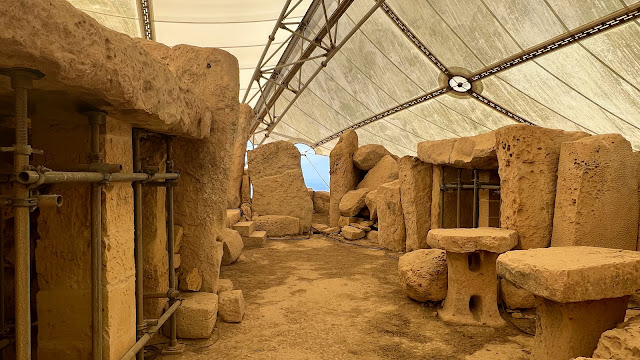Today, the last day of our Sicily-Malta tour, was chock-a-block starting with a visit to the Blue Grotto near Qrendi on the southern coast. No way the bus was driving down the narrow ‘road’ to the harbour so we disembarked and loped down the steep road to the wee harbour where local fishermen had their little fishing boats lined up for us to climb aboard. It was a tight fit but we were fine and safe (in our life jackets) as we went chugging along the cliff face.
Our boat ducked in and out of deep dark watery caverns in the cliff face (not the best sea caves we’ve been in!). At the entrance to the caves where the sun struck the water it reflected a startling phosphorescent blue. Quite dazzling really.
 |
| The blue was electric! |
We would have liked to linger longer but I think the fishermen had other fee-paying tourists in mind so we headed back to port. The climb back up to the village where our bus was parked was steep so we paid a few Euro and clung on for our lives to the back of an electric buggy which whisked us up to the top. We descended a wee way on foot for a cool drink but then it was time to head on to the megalithic stone temples of Ħaġar Qim and Mnajdra.
 |
| Torri Xutu a C17th coast watch tower. Several were positioned along the coastline. |
Our guide walked us through the visitor centre at the perimeter of the archaeological site to explain what we were about to see. These structures, ancient temples, date back to between 3200 and 3600 BC - they are 1000 years older than the pyramids of Egypt and some of the oldest religious structures in the world. The architecture of the structures is quite phenomenal. Amongst other things, it allowed the people/priests to measure the passing of the year and to also map the stars.
 |
| The door was positioned so that the light fell on different panels inside depending on the time of day and year. |
 |
| A model of the Hagar Qim archaeological site |
On the short walk from there to the site (in blistering heat!) we came upon a humble but quite magnificent carob tree. I’d never seen one before. It was huge with large seed pods like fava beans hanging in clusters. Our guide plucked a ripe one and broke it open. Inside was a small seed, called a carat! You may already know this but in the time before weighing scales, diamond traders measured the weight of a diamond by the seeds of the Carob tree, the carats. Pretty simple - obviously the seeds are a fairly constant size. A humble technique that has survived through the millennia.
 |
| A carob tree |
 |
| Carob pods |
 |
| A carat - a carob seed |
But on to the Hagar Qim archaeological site. It is a temple complex dating back almost 6000 years and one of the most ancient religious sites on Earth. It was a fascinating site, the restoration quite phenomenal and the history engrossing.
 |
| The entire site is protected at least from the sun and much of the wind - it is in an exposed position |
 |
The island in the distance is Filfla, a globally important bird area.
The British once used it as bombing target practice! |
 |
| In the most unusual places! |
 |
| We were there |
The other site, Mnajdra was approximately 500m further down the cliff. It was built around the 4000 BC. Some walked down to it but we chose to stay behind.
 |
| A bit of repair work to the dry-stone walls on local properties |
From the sea to the cliff tops and back again! After our scorching visit to Hagar Qim-Mnajdra temples complex, we had a heavenly much=needed break on the waterfront in Marsaxlokk harbour = picturesque with its multicoloured, painted boats. We had lunch and deliciously cold drinks at Harbour Lights, a delightful café on the water.
 |
| Tempura fish and Calamari fritti |
 |
| Our waiter treated us to a couple of local liqueurs made from cactus fruit (L) and carob (R) |
 |
| This pretty boat is a cats' home. There are small doors cut in the hull. |


































No comments:
Post a Comment